SPECIAL FOCUS
The Spirit of Urban Beauty
Chicago's "Spirit of Music Garden" draws lunch crowds, swing dancers,
artists and city folks just looking for a pretty place to sit
BY KATHERINE GIERUT
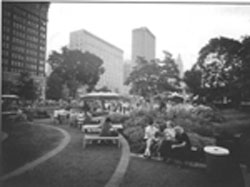
|
Hurt en Urbe, or "Garden
in the City," has been the
motto of the Chicago Park
District since its inception
in 1934 and remains the
guiding principle of the
district to this day.
With a vast canvas to
work with—26 miles of shoreline and
more than 7,400 acres of land spread
throughout 520 neighborhood parks the park district is in the business of urban
beautification every day. The parks must
be as inviting visually as they are culturally
enriching, while catering to both the
passive and active needs of the district's
more than 20 million annual customers.
Under the leadership of General
Superintendent Carolyn Williams Meza,
during the last two years the Chicago Park
District has initiated an elevated landscape
maintenance program and an extensive
garden initiative. Designed to foster and
maintain quality park landscapes, the
program has resulted in some of the most
beautiful gardens the city of Chicago has
ever seen.
|
"Our parks must be a place where
people come to enjoy... enjoy the tranquility, enjoy the gardens, enjoy our many
activities, but most of all, enjoy quality
time with friends and family," says
Williams Meza.
"Therefore, we must constandy
challenge ourselves to deliver the very best
parks and programs we can for our
customers: the citizens of Chicago and the
world."
Among the many examples of new,
innovative gardens in Chicago, stands one
that embodies the concept of urban
beautificarion. Located in Grant Park bordered by Balbo Drive, Michigan
Avenue, Harrison Street and the former
Illinois Central (1C) railroad tracks—this
garden was basically a forgotten space that
was not being used to its full
potential.
The goal was to revitalize
this area to make it more
user-friendly for the growing
community in the downtown
and South Loop areas of
Chicago. The South Loop,
home to a number of colleges and
businesses, has seen a boom in residential
development and, in turn, a whole new
group of people who use the park.
As the park district began working on
preliminary plans for the new garden, a
number of urgent issues came to the table.
The city's Millennium Park Project was set
to begin construction on a 16.5-acre space
just west of Grant Park in early 1999 and
continue through the year 2000. This
posed a challenge for the city's Cultural
Affairs Department to relocate a number
of activities previously held on or adjacent
to this site, including Chicago Summer
Dance and Gallery 37 in the Parks.
However, it also created a tremendous
opportunity to make this garden much
more than just an urban beautificarion
September/October 1999 / 37
SPECIAL FOCUS
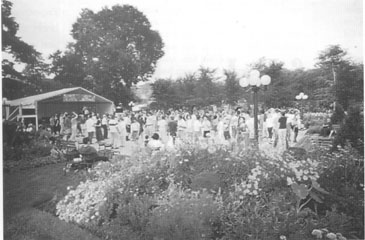
|
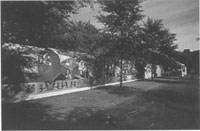
At Left:
Each year hundreds head to the dance floor as part of the
Chicago Summer Dance program, which has Found a
temporary home in the Chicago Park Districts Spirit or
Music Garden in the South Loop area of the city.
Photograph by Chris McGuins.
Right:
Larger than life murals are painted in the garden by
youths from the Gallery 37 in the Parks program.
Photograph by Chris McGuire. |
When the music
starts the garden fills with people
project. The garden would not only
be beautiful, it would be the
temporary home to these wonderful
activities. And so the design priorities
were reassessed.
In an effort to assist the Department of Cultural Affairs, the park
district began to rethink the design
elements for this Grant Park area.
Starting in November 1998, a
number of agencies came together to
discuss plans for this space that would be
called the "Spirit of Music Garden."
Ironically, the name—in honor of the
large bronze statue entitled "The Spirit of
Music" that watches over the park embodies the concept of what the site
would soon become: a multipurpose
garden filled with music and a lot of spirit.
Dan Purciarello, Chicago Park District
project manager for the Spirit of Music
Garden, worked with the city of Chicago's
Department of Cultural Affairs and
Department of General Services, and the
Mayor's Office of Special Events to create a
garden that fulfilled program needs as well
as a garden that was a unique draw in and
of itself.
Chicago Summer Dance required the
most space and materials for their three month long dance and music program.
First, there was a need for a stage to hold
the musical performers. This resulted in a
wooden stage that was erected at the north
end of the garden which includes a gently
sloping ramp at the back. The ramp allows
handicap accessibility as well as a perfect
method for performers to move their
equipment to the stage. Since this was a
dance program, the grass would need to be
covered by a hard surface. A large plastic
dance floor made from recycled materials
was placed directly in front of the stage.
This cut down on the amount of space
that would be effected by construction.
Since the dance program runs until 9:00
p.m., temporary antique lighting was
installed at the corners of the dance floor
to allow participants to enjoy the program
well into the evening. And, because a
number of people attending Chicago
Summer Dance just want to sit back and
enjoy the music, a seating area was
designed near the dance floor that includes
a reusable art piece by Dan Peterman
called "Running Table." The interactive art
is actually a number of recycled plastic
picnic tables all connected together to
create one large table. The concept is to
bring all people to one table, but it also
serves as a great new site for people to sit,
relax and watch the fun.
"Gallery 37 in the Parks" is in neighborhoods throughout Chicago and offers
cultural activities, enrichment and
education for youths in a variety of
mediums. Some Gallery 37 programs, like
creative writing, don't require much more
38 / Illinois Parks and Recreation
THE SPIRIT OF URBAN BEAUTY
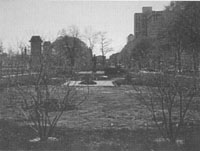
|
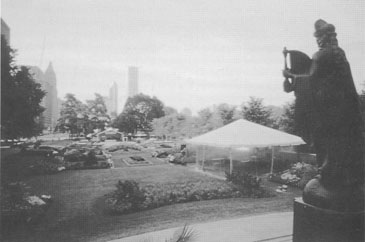
At Left: A view of the garden under construction in 1999. Photograph countest of Chicago Park District.
Right: View of the garden looking north, from the vantage point of the Spirit of Music statue, which inspired the garden's name. Photograph by Chris McGuire. |
than a tent. To meet this need, a grassy
space at the south end of the garden was
¦ left open to house a number of more
passive activities in the Spirit of Music
Garden. This strikes a symmetrical balance
with the stage area directly to the north.
However, Gallery 37 also has activities
like the mural program where youths paint
on large metal panels to create larger-than-
life works of art. These large panels are
mounted on a temporary structure built at
f the rear of the garden and will be left up
for the duration of the program. At the
completion of the program the wall will be
¦ removed and no trace will be left behind.
Given the temporary nature of these
programs, at the core of the design of the
Spirit of Music Garden is its garden. The
park district uses a combination of annuals
and perennials that will guarantee a splash
of color throughout the summer. The
garden layout incorporates a geometric
design that pulls the visitor into the center
of the garden, where they can easily access
all other areas. Classic-looking wooden
umbrellas, tables and chairs circle the
center of the garden, encouraging people
to sit and enjoy their surroundings.
When the programs are over the park
district will still have a beautiful urban
space. The dance floor, tents, temporary
lighting and mural will be removed but-
because the layout was designed with this
in mind—the garden will stand on its own
merit. Turf replacement will need to be
done on the grass that was under the
dance floor and tents and in high-traffic
areas, but, other than that, the garden will
show no trace of what was once there.
"Programs in urban spaces are often
force into an available space, which
sometimes may not be the most conducive
to the project," says Dan Purciarello.
"But the Spirit of Music Garden was a
unique project that took the programs as
well as their absence into consideration."
The real success of this project can be
seen in the people now filling the once
quiet area. Students from nearby colleges
use the space for their art projects, a
number of people sit at the tables and
enjoy the sunshine and others just stroll
through the garden admiring the beautiful
flowers.
When the music starts the garden fills
with people. Dancers hit the floor while
others enjoy just watching the action.
Michael Orlove, Cultural Affairs program
director, estimates that between 300 and
500 people turn out for Summer Dance
every Thursday through Sunday night
during the summer.
"This site has really energized the South
Loop area," says Purciarello.
"Working with these other sister
agencies, we have really created a working
garden that gets people involved and
beautifies the city."
"To have functioning programs in such
a beautiful site is wonderful," says Orlove.
"We receive compliments on a daily basis
about the programs, and everybody loves
the flowers."
While the Chicago Park District works
on urban beautification everyday, the
Spirit of Music Garden is a picture-perfect
example of "function with grace." The
garden is as practical as it is beautiful, and
serves as a tremendous model for parks
facing similar design challenges.
KATHERINE GIERUT
is a communications specialist for the Chicago
Park District.
September/October 1999 /39
SPECIAL FOCUS
Chicago's District-wide Urban Beautification
Flowers Everywhere
Annuals and perennials are planted in gardens in parks throughout the city of Chicago—from Grant Park, to Jackson
Park, to Lincoln Park. These sites provide lush, colorful landscapes that enhance the cityscapes. The floral beds in front of
the Chicago Park District Administration Building are planted year-round and reflect the types of plants featured at the
five annual flower shows at the park district's Garfield Park and Lincoln Park Conservatories. Highlighted below are three
innovative, district-wide urban beautification projects.
|
School Garden Initiative
Encouraging Children To Think Green
This program builds upon the Mayor Daley School Park Program by
creating gardens on school grounds to serve as training and learning
resources. A school garden links classroom learning with the creation,
maintenance and study of a garden. This program is a joint effort with
the city of Chicago's Department of Planning and Development,
Chicago Botanic Garden, Chicago Public Schools, Garfield Park
Conservatory and Openlands Project
Green Deed Tree Dedication Project
Adding To Park Green Space
This program allows people to purchase a tree to be planted in one of
over 500 parks and playgrounds in the city. Buyers receive a "Green
Deed" certificate of ownership that describes the tree planted, the
location, and the person or event being honored. The program, which
has already resulted in hundreds of donated trees, is an environmental
way to beautify the city and celebrate loved ones. Trees are available
starring from $250. For more information call 312.747.2728. |
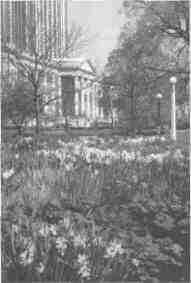
|
Osaka Garden
Cultures Embracing Beautification
The first foreign government to lead the way in support of the 1893 World 's Colombian Exposition was Japan. As part of
their commitment to the fair, the Japanese government built a replica of the famous Phoenix Hall in Uji Japan on
Jackson Park's Wooded Island. The replica was called "Ho-o-den Pavilion." As part of their gift they also added minor
landscape improvements to complement the structure, and this was the beginning of the Osaka Garden. The area was
further developed into a Japanese Garden in 1934 as an attraction to visitors attending the Century of Progress World's
Fair. The Ho-o-den Pavilion stood in Jackson Park until it was destroyed by fire in 1944. In 1981 the Park District
renovated the garden and added a waterfall and in 1992 Chicago officials renamed the area Osaka Garden to honor their
Sister City. Osaka donated $250,000 for a new entrance gate. The new garden gate is of typical Japanese design, heavily
influenced by the traditions of Buddhism and Shintoism. There is currently an Osaka Garden Committee, which includes
representatives from Frank Lloyd Wright Home and Studio, the Museum of Science and Industry, Chicago Sister Cities
International Program, Friends of the Parks and others who are working with the park district to develop programs and
activities to bring additional visitors to the garden.
- by Kotherine Gierut
Photograph: Flower beds color the front of the Historical Society in Lincoln Park.
Photograph courtesy of the Chicago Park District.
40 / Illinois Parks and Recreation





